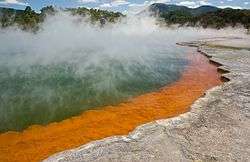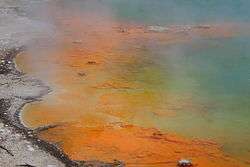Champagne Pool
Champagne Pool is a prominent geothermal feature within the Waiotapu geothermal area in the North Island of New Zealand. The terrestrial hot spring is located about 30 km (20 mi) southeast of Rotorua and about 50 km (30 mi) northeast of Taupo. The name Champagne Pool is derived from the abundant efflux of carbon dioxide (CO2), similar to a glass of bubbling champagne. The hot spring was formed 900 years ago by a hydrothermal eruption,[1] which makes it in geological terms a relatively young system. Its crater is around 65 m (213 ft) in diameter with a maximum depth of approximately 62 m (203 ft) and is filled with an estimated volume of 50,000 m3 (1,800,000 cu ft) of geothermal fluid.[2]
| Champagne Pool | |
|---|---|
 The orange colour originates from deposits of arsenic and antimony sulfides. | |
| Location | Waiotapu, North Island |
| Coordinates | 38.359086°S 176.368901°E |
| Type | geothermal |
| Basin countries | New Zealand |
| Max. length | 65 m (213 ft) |
| Max. depth | 62 m (203 ft) |
| Water volume | 50,000 m3 (1,800,000 cu ft) |
| Residence time | 34 days |
Hydrochemistry

The deep geothermal water below Champagne Pool is of the order of 260 °C (500 °F)[3] but water temperature within the pool is maintained at 73 °C (163 °F) to 75 °C (167 °F) by losing heat to the atmosphere. The pH of 5.5 is relatively constant due to buffering by the flux of CO2. Gases are mainly CO2, but to less extent nitrogen (N2), methane (CH4), hydrogen (H2), hydrogen sulphide (H2S) and traces of oxygen (O2).[4] The siliceous geothermal fluid is oversaturated with metalloid compounds such as orpiment (As2S3) and stibnite (Sb2S3), which precipitate and form orange subaqueous deposits.[5] The colourful deposits are in sharp contrast to the grey-white silica sinter surrounding Champagne Pool.
Biology
Although Champagne Pool is geochemically well characterised, few studies have addressed its role as a potential habitat for microbial life forms. H2 and either CO2 or O2 would be available as metabolic energy sources for autotrophic growth of methanogenic or hydrogen-oxidising microorganisms. Culture-independent methods provided evidence for filamentous, coccoid and rod-shaped cell morphologies in the hot spring.[4][6][7] Two novel bacteria and a novel archaeon have been successfully isolated from Champagne Pool.[8] Bacterial isolate CP.B2 named Venenivibrio stagnispumantis tolerates relatively high concentrations of arsenic and antimony compounds and represents a novel genus and species within the order Aquificales.[9]
See also
References
- Lloyd, E. F. (1959). "The hot springs and hydrothermal eruptions of Waiotapu". New Zealand Journal of Geology and Geophysics. 2 (1): 141–76. doi:10.1080/00288306.1959.10431319.
- Hedenquist, J. W. (1986). "Geothermal systems in the Taupo Volcanic Zone: Their characteristics and relation to volcanism and mineralisation". Bulletin of the Royal Society of New Zealand. 23: 134–68.
- Giggenbach, W; Sheppard, D; Robinson, B; Stewart, M; Lyon, G (1994). "Geochemical structure and position of the Waiotapu geothermal field, New Zealand". Geothermics. 23 (5–6): 599. doi:10.1016/0375-6505(94)90022-1.
- Jones, B.; Renaut, R. W.; Rosen, M. R. (2001). "Biogenicity of gold- and silver-bearing siliceous sinters forming in hot (75 C) anaerobic spring-waters of Champagne Pool, Waiotapu, North Island, New Zealand". Journal of the Geological Society. 158 (6): 895. Bibcode:2001JGSoc.158..895J. doi:10.1144/0016-764900-131.
- Pope, J. G.; Brown, K. L.; McConchie, D. M. (2005). "Gold Concentrations in Springs at Waiotapu, New Zealand: Implications for Precious Metal Deposition in Geothermal Systems" (PDF). Economic Geology. 100 (4): 677–87. doi:10.2113/gsecongeo.100.4.677. Archived from the original (PDF) on 2011-09-27.
- Mountain, B. W.; Benning, L. G.; Boerema, J. A. (2003). "Experimental studies on New Zealand hot spring sinters: Rates of growth and textural development". Canadian Journal of Earth Sciences. 40 (11): 1643. Bibcode:2003CaJES..40.1643M. doi:10.1139/e03-068.
- Phoenix, V. R.; Renaut, R. W.; Jones, B.; Ferris, F. G. (2005). "Bacterial S-layer preservation and rare arsenic-antimony-sulphide bioimmobilization in siliceous sediments from Champagne Pool hot spring, Waiotapu, New Zealand". Journal of the Geological Society. 162 (2): 323. doi:10.1144/0016-764903-058.
- Hetzer, Adrian; Morgan, Hugh W.; McDonald, Ian R.; Daughney, Christopher J. (2007). "Microbial life in Champagne Pool, a geothermal spring in Waiotapu, New Zealand". Extremophiles. 11 (4): 605–14. doi:10.1007/s00792-007-0073-2. PMID 17426919.
- Hetzer, A.; McDonald, I. R.; Morgan, H. W. (2008). "Venenivibrio stagnispumantis gen. nov., sp. nov., a thermophilic hydrogen-oxidizing bacterium isolated from Champagne Pool, Waiotapu, New Zealand". International Journal of Systematic and Evolutionary Microbiology. 58 (2): 398–403. doi:10.1099/ijs.0.64842-0. PMID 18218938.
External links
![]()
